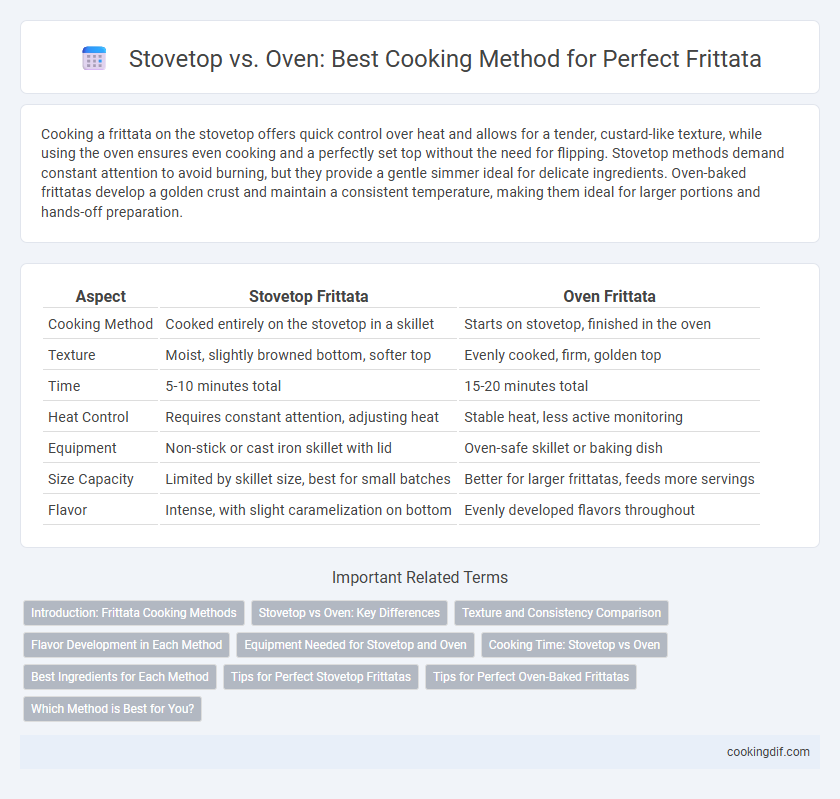Cooking a frittata on the stovetop offers quick control over heat and allows for a tender, custard-like texture, while using the oven ensures even cooking and a perfectly set top without the need for flipping. Stovetop methods demand constant attention to avoid burning, but they provide a gentle simmer ideal for delicate ingredients. Oven-baked frittatas develop a golden crust and maintain a consistent temperature, making them ideal for larger portions and hands-off preparation.
Table of Comparison
| Aspect | Stovetop Frittata | Oven Frittata |
|---|---|---|
| Cooking Method | Cooked entirely on the stovetop in a skillet | Starts on stovetop, finished in the oven |
| Texture | Moist, slightly browned bottom, softer top | Evenly cooked, firm, golden top |
| Time | 5-10 minutes total | 15-20 minutes total |
| Heat Control | Requires constant attention, adjusting heat | Stable heat, less active monitoring |
| Equipment | Non-stick or cast iron skillet with lid | Oven-safe skillet or baking dish |
| Size Capacity | Limited by skillet size, best for small batches | Better for larger frittatas, feeds more servings |
| Flavor | Intense, with slight caramelization on bottom | Evenly developed flavors throughout |
Introduction: Frittata Cooking Methods
Stovetop cooking for frittatas allows precise temperature control and quicker preparation, ideal for softer textures and fluffy results. Oven baking evenly cooks the frittata through, creating a firm, golden crust and is suitable for larger, thicker dishes. Choosing between stovetop and oven methods depends on desired texture, cooking time, and portion size.
Stovetop vs Oven: Key Differences
Stovetop frittatas cook faster with direct heat, allowing for easy monitoring and stirring, resulting in a more textured and slightly browned bottom. Oven-baked frittatas provide even, gentle heat that ensures consistent cooking throughout, producing a fluffy and uniformly set dish. The stovetop method suits small batches and quick meals, while the oven method excels for larger portions and hands-free cooking.
Texture and Consistency Comparison
Stovetop frittatas typically yield a creamier texture with a softer and more tender interior due to gentle, consistent heat, allowing for slow cooking and preventing over-browning. Oven-baked frittatas develop a firmer, more set consistency with a slightly crispy top and edges, providing a contrast between a golden crust and a dense, sliceable center. Choosing the stovetop method emphasizes moisture retention and custard-like smoothness, while oven cooking enhances a more structured and visually appealing presentation.
Flavor Development in Each Method
Stovetop cooking promotes intense caramelization and Maillard reactions, resulting in a richly flavored crust and a slightly smoky taste for the frittata. Oven baking ensures even heat distribution, preserving delicate herb aromas and producing a tender, custardy interior with subtle browned edges. Combining both methods can maximize flavor complexity by marrying stovetop searing with gentle oven finishing.
Equipment Needed for Stovetop and Oven
Cooking a frittata on the stovetop requires a non-stick, oven-safe skillet or frying pan and a heat diffuser for even cooking. In contrast, oven baking demands a reliable, ovenproof baking dish or cast-iron skillet and preheated conventional or convection oven. Choosing the right equipment ensures consistent heat distribution and a perfectly cooked frittata texture.
Cooking Time: Stovetop vs Oven
Stovetop frittatas typically cook faster, taking about 10 to 15 minutes, as direct heat allows for quick and even cooking. Oven-baked frittatas usually require 20 to 30 minutes, benefiting from gentle, uniform heat that ensures thorough cooking and a consistent texture. Choosing stovetop or oven depends on desired texture and time availability, with stovetop offering speed and oven providing a tender finish.
Best Ingredients for Each Method
Stovetop frittatas benefit from ingredients that cook quickly and evenly, such as thinly sliced vegetables, pre-cooked meats, and fresh herbs, allowing for uniform heat distribution without burning. Oven-baked frittatas accommodate heartier ingredients like denser vegetables, raw potatoes, or thicker cuts of meat, as the consistent, surrounding heat ensures thorough cooking. Cheese varieties like mozzarella or goat cheese work well in stovetop frittatas for melting, while firmer cheeses like cheddar or Parmesan complement the longer baking time in the oven.
Tips for Perfect Stovetop Frittatas
For perfect stovetop frittatas, use a nonstick skillet with an oven-safe lid to ensure even cooking and prevent sticking. Cook over medium-low heat to allow the eggs to set gently without browning too quickly, stirring occasionally to distribute heat and ingredients. Finish by letting the frittata rest off the heat to fully set and enhance the texture before serving.
Tips for Perfect Oven-Baked Frittatas
For perfect oven-baked frittatas, preheat the oven to 350degF (175degC) to ensure even cooking throughout. Use an oven-safe skillet, such as cast iron, to maintain heat and achieve a golden top without burning the edges. Bake the frittata for 20-25 minutes until the center is set and a toothpick inserted comes out clean, avoiding overbaking to maintain a creamy texture.
Which Method is Best for You?
Stovetop cooking offers quick, controlled heat for a soft, custardy frittata with a slightly crispy bottom, ideal for small batches or when time is limited. Oven-baking ensures even cooking and a firm, fluffy texture, perfect for larger portions and hands-off preparation. Choose stovetop for speed and precision or oven for ease and consistent results depending on your kitchen setup and recipe size.
Stovetop vs Oven for frittata cooking method Infographic

 cookingdif.com
cookingdif.com